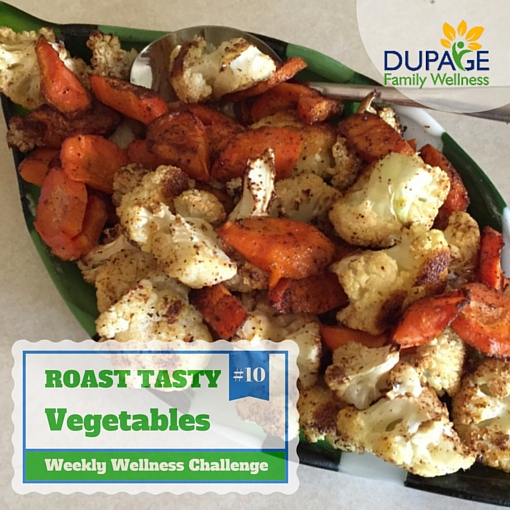 Until about 4 years ago I didn’t eat vegetables. Period. I was convinced that vegetables didn’t taste good. Now I love vegetables. Just this afternoon I had brussels sprouts as an afternoon snack. Delicious!
Until about 4 years ago I didn’t eat vegetables. Period. I was convinced that vegetables didn’t taste good. Now I love vegetables. Just this afternoon I had brussels sprouts as an afternoon snack. Delicious!
So what changed?
I learned how to cook vegetables so that they taste good!
Keep reading for the basic method of roasting vegetables that changed my life. I roasted vegetables for my picky husband and my dad, and now they enjoy eating vegetables too.
They key to making vegetables that taste good is the use of fat. Not only does the fat make the vegetables taste delicious, it is good for you. Check out this article that explains how eating vegetables with fat enables your body to better absorb the fat soluble vitamins. Patients often tell me about their bland boiled or steamed vegetables, and I remind them not to be afraid of fat.
Simple and Delicious Roasted Vegetables
Ingredients
- Vegetable(s) of choice – our favorites include broccoli, carrots, brussels sprouts, cauliflower, asparagus and sweet potato. You can also try eggplant, acorn squash, butternut squash, fennel, beets, onions, turnips, parsnips, and more!
- 1-2 tbsp of fat of choice – coconut oil, butter, ghee, or animal fat (e.g. lard, beef tallow)
- Salt and pepper to taste
Directions
- Preheat oven to 425. Spoon fat onto 9x13 glass pan or cookie sheet with rimmed edges. Place pan in the oven to melt fat.
- Cut vegetables into uniform pieces (i.e. florets, match sticks, cubes etc).
- Mix vegetables in the melted fat and season with salt and pepper. Make sure vegetables are in a single layer on pan.
- Roast vegetables in oven. Cooking time varies based on the vegetable. For heartier vegetables like broccoli, cauliflower, carrots, and sweet potatoes cook for 25-30 minutes. Asparagus is 15-20 depending on the thickness. Look for the vegetables to soften (tender when forked) and start to brown on the edges.
- Remove pan from oven and let veggies rest for 5-10 minutes in hot pan. This helps them to crisp up a bit. If you want to make it really tasty, and you tolerate dairy well, serve with butter.
More ideas:
- This technique can be used with frozen vegetables. However, in my opinion the texture is not quite as good.
- Mix 2 types of veggies that cook the same length of time (e.g. carrots and cauliflower or broccoli).
- Once you start to enjoy vegetables, it becomes easy to substitute grilled or roasted vegetables for the fries in a restaurant. Soon you will realize that the vegetables have more flavor than the fries.
- Experiment with seasonings. For example, give the vegetables "kick" by dusting with chili power and cumin, and adding a shake of cinnamon and red pepper before you mix the vegetables with the fat.
- For particularly picky eaters, if they tolerate cheese, grate some over the veggies when you remove them from the oven.
Your Challenge: Try roasting a new vegetable this week.
We’d love to hear from you. What did you try? Do you have other easy ways to prepare vegetables that taste good?
Article by: Joelle Kurczodyna, NTP
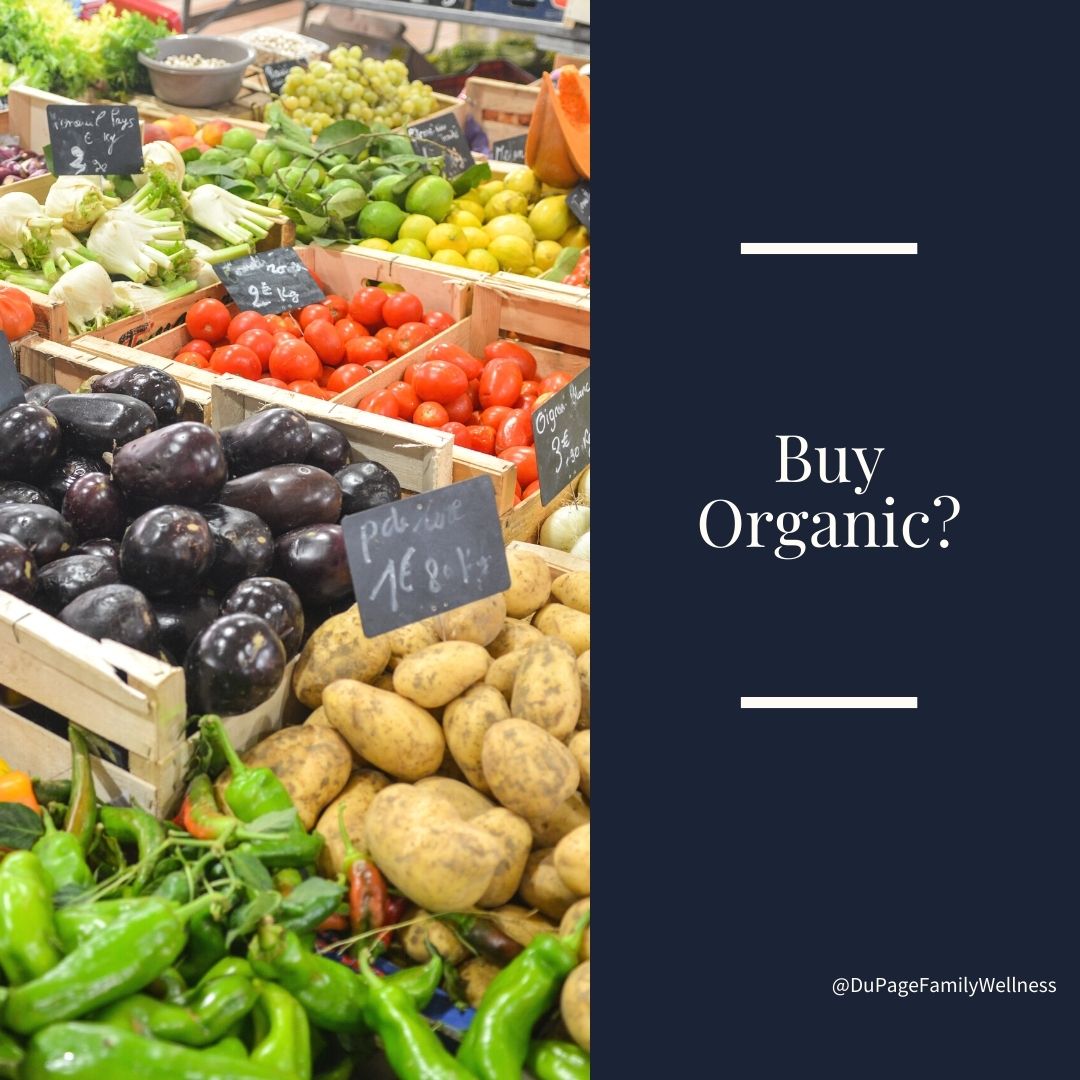 I've wondered whether there is enough benefit in organic produce to justify the extra cost. Since I changed my diet to "eat real food", I thought that eating meats and vegetables, rather than processed foods, was good enough. A few weeks ago, I attended a nutrition seminar and the topic of buying organic came up. I had one of those "lightbulb" moments.
I've wondered whether there is enough benefit in organic produce to justify the extra cost. Since I changed my diet to "eat real food", I thought that eating meats and vegetables, rather than processed foods, was good enough. A few weeks ago, I attended a nutrition seminar and the topic of buying organic came up. I had one of those "lightbulb" moments.
The doctor teaching the seminar explained that toxins are stored in your fat cells. The body wants a barrier from the toxins, so it creates more fat to act as a buffer around the toxic substances. WOW!!
Usually, people think that you put on fat when you consume more calories than you burn. Current research, however, shows that fat results when hormones and blood sugar are out of balance.
While I have understood for a while that the food we eat impacts our hormones, I didn't make the connection that our bodies were purposely contributing to this hormonal change in order to protect us.
Could eating non-organic foods, doused in chemicals, contribute to weight gain?
I did more research, and found that the chemicals in and on foods, even food normally considered to be healthy, can disrupt our hormone balance and contribute to weight gain!
There is a new word, obesogen, used to describe these substances. Many articles, both technical and mainstream, describe "How Chemicals in Food can Make You Fat."
Obesogen: Chemicals that inappropriately alter lipid homeostasis and fat storage, change metabolic setpoints, disrupt energy balance or modify the regulation of appetite and satiety to promote fat accumulation and obesity.
How did we get into this situation?
A Look Back at History
Organic farming is not new. The book "Founding Gardeners: The Revolutionary Generation, Nature, and the Shaping of the American Nation" by Andera Wulf explains the passion our founding fathers had for the land. Gardening, agriculture, and botany were ingrained in the character of George Washington, Thomas Jefferson, James Madison and John Adams, and farming was part of the vision of greatness of the new nation. Until agricultural chemicals and pesticides came on the scene, what we call organic farming today was just normal farming.
During WWII, The US military used DDT to control the spread of diseases in Europe and in the Pacific. Right after the war, DDT was released to agricultural companies and became the gold standard for insecticides. In fact, agriculture received most of the leftover chemicals created for war time use. Other chemicals were used in fertilizers. At this time, it was not known that these materials were highly toxic and carried very dangerous risks.
When farmers began using these new chemicals, consumers were not aware of the change in the new pesticide laden products. The use of pesticides and fertilizers grew rapidly, and is the standard practice today. When word got out that the new way of farming included toxic materials, it gave rise to the “organic” movement.
What does the USDA Organic Label mean?
You’ve probably seen the small green USDA Organic label on fruits, vegetables, and other products. To earn this label, the growing area must be free of chemical synthetic pesticides for at least three growing seasons. If a product has multiple ingredients, 95% of ingredients must be grown organically in order to earn the Certified USDA Organic seal.
Is There a Better Option than Organic Produce?
Yes! Foods grown locally and in season have more nutrients than organic foods purchased from the grocery store. When out of season produce is shipped across the country or across the ocean to your local grocery store, the nutrient value starts to deplete as soon as the food is harvested. The longer food has been out of the ground before you eat it, the greater reduction in vitamins and nutrients. Many small local farms are not able to call their crops "organic" because qualifying for this label is too expensive. Talk to the farmer and ask them about their farming practices.
Recommendations
The best option is to buy organically grown produce from a local farmer. Go to a local farmer’s market (Illinois Directory) or buy through a Community Supported Agriculture program (CSA). The second option is to buy organic produce whenever possible. The Environmental Working Group measures the toxins on/in produce grown conventionally (using synthetic fertilizers and pesticides). They publish the most contaminated on a list called the "Dirty Dozen", and least pesticide laden on a list called the "Clean Fifteen". More details can be found at the Environmental Working Group website.
Your Challenge
Think about the produce that you buy this week and look at the dirty dozen list below. For those items on your shopping list, look for an organic option in your grocery store. Or better yet- check out a local farmer’s market and get some fresh local produce that is in season! Start paying attention to the source of your food.
2021 Dirty Dozen - 12 Most Contaminated (Buy Organic when possible)
- Strawberries
- Spinach
- Kale, collard & mustard greens
- Nectarines
- Apples
- Grapes
- Cherries
- Peaches
- Pears
- Bell & hot peppers
- Celery
- Tomatoes
2021 Clean 15 (okay to buy these conventionally)
- Avocado
- Sweet corn (be careful of GMO)
- Pineapples
- Onions
- Papayas
- Sweet peas
- Eggplant
- Asparagus
- Broccoli
- Cabbage
- Kiwi
- Cauliflower
- Mushrooms
- Honey dew melons
- Cantaloupe
Where you buy organic or local foods? Do you recommend a CSA? Let us know on Facebook!
Dr, Jamie Thomure and Joelle Kurczodyna, NTP
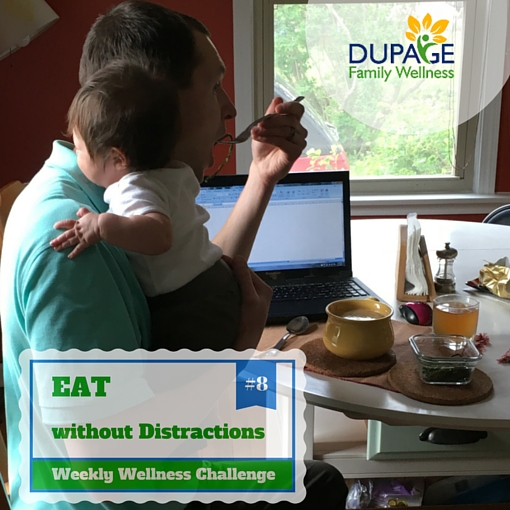 Did your mother tell you "Don't swim until 30 minutes after eating." Does that "rule" seem silly? Is it an old wives tale? Maybe not! It makes sense when you understand how digestion works.
Did your mother tell you "Don't swim until 30 minutes after eating." Does that "rule" seem silly? Is it an old wives tale? Maybe not! It makes sense when you understand how digestion works.
The body is always in one of two states: parasympathetic or sympathetic. The parasympathetic is the state of calm and rest. The sympathetic is the state of stress, also known as "fight or flight". Digestion only occurs in the parasympathetic state.
Think about it, if you are eating your lunch and a pack of tigers comes, your body will prioritize running away as fast as possible (sympathetic state). It will forget about digesting your lunch (parasympathetic state). This example may seem extreme, but in today’s fast paced world, your body confuses everyday stresses with the same response as it would if you were being chased by a pack of tigers.
Furthermore, it's not just physical stress that causes your body to go into the sympathetic state. Any stress, including mental or emotional stress, can trigger the sympathetic response.
Think about your typical meal times.
- Do you eat breakfast while fighting traffic to get to work?
- Is lunch spent at your desk while working or quickly doing other tasks in that brief window of time?
- Do you eat dinner while watching TV or on your phone?
All of these activities could signal your body that you are in a stressed state. You are not focused on the task at hand – eating. When this happens, your body will prioritize dealing with stress, at all costs, over digestion. If you aren't digesting your food well, some symptoms you might experience are diarrhea, constipation, gas, or bloating.
Although this week’s challenge sounds simple it may be difficult until we train ourselves to do it.
Your challenge this week:
During meal times – Eat Without Distractions. Make eating the one and only “task” at hand.
Think about what you are eating and how it tastes. Take time to chew your food and enjoy it. If you do this, I have no doubt you will not only enjoy your food more but also feel better after eating it.
We'd like to hear how this challenge goes for you. Let us know on our facebook page!
Joelle Kurczodyna, NTP
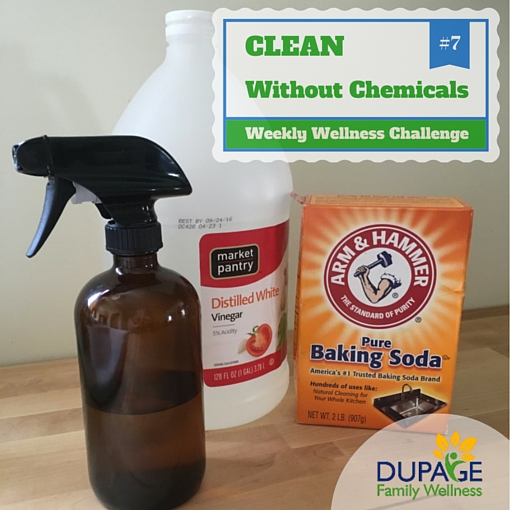 Spring Cleaning…Naturally!
Spring Cleaning…Naturally!
When I got married, I quickly learned that my husband was one of those “clean” people. He cleaned things that I wouldn’t even think of cleaning – walls, fans, ceilings, etc. As someone who grew up resisting when my mom asked me to put things away before the cleaning lady came (spoiled, I know), I had a lot to learn (and still do) in this area.
When we changed our diet to "eat real food", we also realized that we wanted reduce our exposure to environmental toxins. This opened up a whole new world of eliminating chemicals from our lives, including those in cleaning products.
What is the Problem?
There have been 85,000 new chemicals introduced in mainstream products since World War II. Most of these are contained in conventional cleaning products, but are not approved by the EPA.
In fact the average household has at least 62 toxic chemicals found in their bathroom or under their kitchen sink that they probably don’t even realize. These chemicals include phtalates (in fragranced products), triclosan (in liquid dishwashing detergent), 2-Butoxyethanol (in multi-purpose cleaners) and even chlorine (in laundry whiteners and toilet bowl cleaners). These chemicals affect the air we breathe, water we drink, and are in the top five causes of child poisoning cases. It is not hard to see the reason that we want to remove these chemicals and products from our homes.
How do we do remove chemicals and still make our sinks shine and our toilets sparkle?
My two favorite ingredients to create my own homemade all purpose cleaner that works wonders are baking soda and vinegar.
All Purpose Cleaner Recipe
Mix:
- ½ cups of vinegar
- ¼ cup baking soda
- into a ½ gallon of water.
Put it in a spray bottle, and use to clean showers, bathrooms, and windows.
Not only can I clean the shower without feeling like I’m going to pass out, but I can also trust that my family is not being harmed by toxic chemicals.
Other Resources for Green Cleaners
If making your own cleaning products isn’t your thing, check out the Environmental Working Group’s guide to the top green cleaning products. Here you can find anything from non-toxic laundry supplies and dish soap to beauty supplies and cosmetics.
What are your favorite natural cleaning remedies or products? Let us know on our facebook page!
Joelle Kurczodyna, NTP
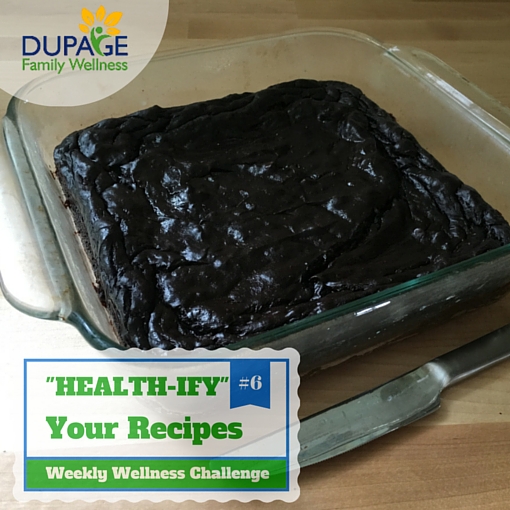 “Health-ify” Your Favorite Meal
“Health-ify” Your Favorite Meal
There are some foods that we absolutely LOVE, but these foods might not be the healthiest choice.
This begs the question – what are “healthy” foods?
I think of healthy foods as the foods that come from only real food ingredients and are rich in nutrients to nourish and fuel your body. There are TWO key components:
- Made from real, unprocessed ingredients AND
- Rich in nutrients.
Generally, if it grew in the ground or was once alive, it is probably nutritious. If it was made in a factory, then think about it more carefully.
To make your favorite foods healthier: Remove the processed ingredients and add more nutrient dense ingredients.
How does this work?
We were having friends over for dinner the other day and I planned to make roasted chicken thighs, asparagus, and sweet potatoes, but I also wanted to include a dessert. I love brownies, but generally brownies are full of sugar and other processed ingredients, especially if you buy the boxed mix. So with help from Google, and little tweaking, I came up with a brownie that satisfied that sweet tooth, contained mostly real ingredients full of nutrients, and was a hit with our dinner guests. See recipe below.
There are many foods that people often think must be included in a meal, such as bread, pasta, rice, potatoes, or tortillas. While these might seem like healthy choices, they tend to be filler foods that are high in calories and carbohydrates, and low in nutrients. Skip them, and replace as follows:
Substitute / Add Vegetables
As a rule of thumb, at least half, if not 2/3 or 3/4 of your plate should be vegetables. Try these ideas to add more veggies:
- Add more vegetables to your family’s favorite soup or casserole. It’s amazing how well veggies cook down and you can add lots of vegetables without changing the dish. Soon your family will like it better this way. Note: This could mean adding more of the same vegetable that the recipe calls for or others that you have on hand.
- Remove the bread, and replace with greens, like spinach. Your sandwich becomes a salad. Similarly, replace tortillas with greens to make taco salad!
- Replace pasta with spaghetti squash, spiralated squash, or other veggies.
- Replace rice, mashed potatoes, or pizza crust with cauliflower rice or mashed cauliflower, or cauliflower crust . This may sound strange but it’s a GREAT way to substitute a food with little nutrients to one that is more nutrient dense and still tastes great!
Make it from Scratch
It is easy to get in the habit of using packaged products because it is easier or you don't know how to make it from scratch. Actually, it's often not that hard to make it from scratch, you just need to be brave, find a recipe, and try it.
- Make homemade mayo – Replace those, processed vegetable oils with healthy fats and natural ingredients. Use your mayo as a base in salad dressing or chicken/tuna/egg salad.
- Replace the canned "cream of xyz" soup in your family favorite casserole and make the real stuff – like this recipe.
Healthified Brownies
In this brownie recipe, the flour, sugar, and vegetable oil are replaced with avocados and bananas.
Ingredients:
- 2 Avocados
- 2 Bananas
- 2 Eggs
- ½ Cup Cocoa Powder
- ¼ Cup Raw Honey
- 1 Tsp Baking soda
- ½ Cup Dark Chocolate chips (Optional)
Method:
Blend avocados, bananas, eggs, cocoa powder, honey, and baking soda – an immersion blender or food processor work well. Stir in chocolate chips if desired Pour into a greased (I use coconut oil) 8x8 baking dish. Bake at 350 for 25-30 min.
This week, use these tips to “health-ify” one of your favorite meals.
Let us know how it goes and share more ideas on our facebook page!
Joelle Kurczodyna, NTP
 Walk More!
Walk More!
How much do you walk each day? How much do you think our ancestors walked each day?
Our ancestors did not sit in front of a computer monitor all day, and then go home to sit in front of the TV. Our ancestors walked to find food and water. Even our grandparents, had jobs and lives that required them to get up and move. As time goes on, inventions like garage door openers, drive up windows, and remote controls continue to make us more sedentary. More and more researchers are coming to the conclusion that sitting too much is more dangerous that smoking, and I agree!
Since life has become so easy, we need to pay attention to keep moving throughout the day. To help you get moving, here are my top 10 tips to add more steps to your daily life!
- Walk and talk- If you are meeting up with a friend, try meeting them for a walk instead of meeting for coffee or a meal! It is amazing how quickly the time passes and how much ground you can cover while engaging in a good conversation (and it’s free!). Have a phone call to make? Pace as you talk on the phone.
- Lunchtime walk- This one is all about habits! Form a habit of walking each day during your lunch break! If you bring your lunch to work there should be some time to get a walk in (and your food will likely be healthier as well!) Get your coworkers involved to make it more fun and hold you accountable!
- Park Further away- I know you have heard this one before- but do you actually do it? I can’t tell you how often I see cars circling parking lots multiple times to find that close spot! There are always spots open in the back of the lot- and you are less likely to have your car dinged by someone’s door or shopping cart!
- Find an indoor spot to walk- Let’s face it- in Chicago there will be bad weather days. Rather than let the weather de-rail your walking, plan an another option for bad weather days. When the bad weather comes, you'll know where to go. Consider a local track or shopping mall!
- Walk more at work- Instead of emailing coworkers, go walk to their desk. Instead of having mail dropped off, go pick it up. Take breaks to walk and go fill up your water bottle. When traveling between floors, use stairs instead of the elevator.
- Try an after dinner walk- Again- this one is about habits. Make a nightly after dinner walk a family ritual! This should be much easier now that it is staying light outside later in the evenings!
- Walk while waiting for carpool duty- If you are picking a child up from school or an activity, instead of waiting in the endless carpool pick up line, park your car, get out, and walk around! Walk you kids to school rather than driving them.
- Use the mile rule- If a destination is less than a mile away, just walk instead of taking your car! While this might not always be convenient, think about the places where you typically go, and of there are any that you could walk to instead of driving. For me, my house isn't convenient to walk anywhere, but from my office I can walk to the post office and the bank if I have a few spare minutes.
- Use a pedometer, pedometer phone app, or fit bit type of device. I noticed that my phone has an app on in that records my steps. Looking at this randomly can be very motivating. If I see that my total is low for the day, it makes me want to get up and get moving! Make it a point to look at your steps at regularly through the day and make some step goals. This can be addictive, and motivate you to get take more steps each day.
- Find a buddy that will commit to walk with you on a regular schedule. You won't let your friend down, and before you know it, you will walk automatically. Make it a habit to walk at a particular time each day. My mom has been walking at 6 am with her neighbors every Monday-Friday for over 25 years!
Looking for a walking buddy? I am going to have my “walk with the doc” program again this summer on Tuesdays and Thursdays on the prairie path by the office. If you are interested in joining me, let me know what time is best for you and I can plan my schedule accordingly based on interest levels!
Pick 1 or 2 of these ideas that work for you, and try it every day this week. Let us know how it goes on our facebook page!
Dr. Jamie Thomure, DC
 Until about 4 years ago I didn’t eat vegetables. Period. I was convinced that vegetables didn’t taste good. Now I love vegetables. Just this afternoon I had brussels sprouts as an afternoon snack. Delicious!
Until about 4 years ago I didn’t eat vegetables. Period. I was convinced that vegetables didn’t taste good. Now I love vegetables. Just this afternoon I had brussels sprouts as an afternoon snack. Delicious! 

 I've wondered whether there is enough benefit in organic produce to justify the extra cost. Since I changed my diet to "eat real food", I thought that eating meats and vegetables, rather than processed foods, was good enough. A few weeks ago, I attended a nutrition seminar and the topic of buying organic came up. I had one of those "lightbulb" moments.
I've wondered whether there is enough benefit in organic produce to justify the extra cost. Since I changed my diet to "eat real food", I thought that eating meats and vegetables, rather than processed foods, was good enough. A few weeks ago, I attended a nutrition seminar and the topic of buying organic came up. I had one of those "lightbulb" moments. Did your mother tell you "Don't swim until 30 minutes after eating." Does that "rule" seem silly? Is it an old wives tale? Maybe not! It makes sense when you understand how digestion works.
Did your mother tell you "Don't swim until 30 minutes after eating." Does that "rule" seem silly? Is it an old wives tale? Maybe not! It makes sense when you understand how digestion works. Spring Cleaning…Naturally!
Spring Cleaning…Naturally! “Health-ify” Your Favorite Meal
“Health-ify” Your Favorite Meal Walk More!
Walk More!